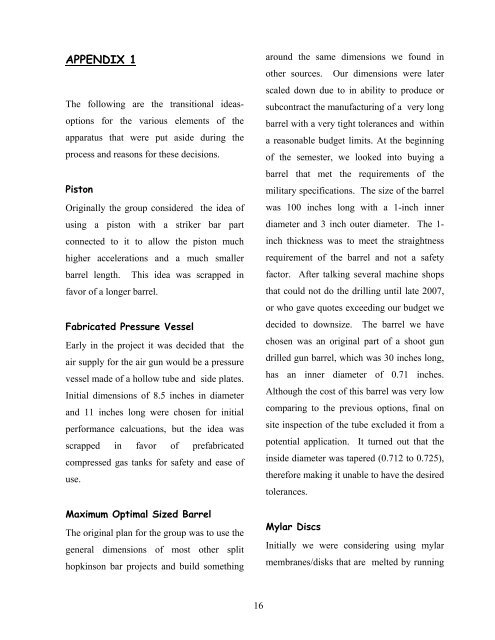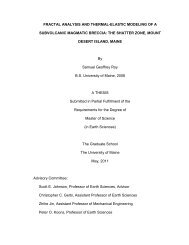design and characteristics of a split hopkinson pressure bar apparatus
design and characteristics of a split hopkinson pressure bar apparatus
design and characteristics of a split hopkinson pressure bar apparatus
You also want an ePaper? Increase the reach of your titles
YUMPU automatically turns print PDFs into web optimized ePapers that Google loves.
APPENDIX 1<br />
The following are the transitional ideasoptions<br />
for the various elements <strong>of</strong> the<br />
<strong>apparatus</strong> that were put aside during the<br />
process <strong>and</strong> reasons for these decisions.<br />
Piston<br />
Originally the group considered the idea <strong>of</strong><br />
using a piston with a striker <strong>bar</strong> part<br />
connected to it to allow the piston much<br />
higher accelerations <strong>and</strong> a much smaller<br />
<strong>bar</strong>rel length. This idea was scrapped in<br />
favor <strong>of</strong> a longer <strong>bar</strong>rel.<br />
Fabricated Pressure Vessel<br />
Early in the project it was decided that the<br />
air supply for the air gun would be a <strong>pressure</strong><br />
vessel made <strong>of</strong> a hollow tube <strong>and</strong> side plates.<br />
Initial dimensions <strong>of</strong> 8.5 inches in diameter<br />
<strong>and</strong> 11 inches long were chosen for initial<br />
performance calcuations, but the idea was<br />
scrapped in favor <strong>of</strong> prefabricated<br />
compressed gas tanks for safety <strong>and</strong> ease <strong>of</strong><br />
use.<br />
Maximum Optimal Sized Barrel<br />
The original plan for the group was to use the<br />
general dimensions <strong>of</strong> most other <strong>split</strong><br />
<strong>hopkinson</strong> <strong>bar</strong> projects <strong>and</strong> build something<br />
16<br />
around the same dimensions we found in<br />
other sources. Our dimensions were later<br />
scaled down due to in ability to produce or<br />
subcontract the manufacturing <strong>of</strong> a very long<br />
<strong>bar</strong>rel with a very tight tolerances <strong>and</strong> within<br />
a reasonable budget limits. At the beginning<br />
<strong>of</strong> the semester, we looked into buying a<br />
<strong>bar</strong>rel that met the requirements <strong>of</strong> the<br />
military specifications. The size <strong>of</strong> the <strong>bar</strong>rel<br />
was 100 inches long with a 1-inch inner<br />
diameter <strong>and</strong> 3 inch outer diameter. The 1inch<br />
thickness was to meet the straightness<br />
requirement <strong>of</strong> the <strong>bar</strong>rel <strong>and</strong> not a safety<br />
factor. After talking several machine shops<br />
that could not do the drilling until late 2007,<br />
or who gave quotes exceeding our budget we<br />
decided to downsize. The <strong>bar</strong>rel we have<br />
chosen was an original part <strong>of</strong> a shoot gun<br />
drilled gun <strong>bar</strong>rel, which was 30 inches long,<br />
has an inner diameter <strong>of</strong> 0.71 inches.<br />
Although the cost <strong>of</strong> this <strong>bar</strong>rel was very low<br />
comparing to the previous options, final on<br />
site inspection <strong>of</strong> the tube excluded it from a<br />
potential application. It turned out that the<br />
inside diameter was tapered (0.712 to 0.725),<br />
therefore making it unable to have the desired<br />
tolerances.<br />
Mylar Discs<br />
Initially we were considering using mylar<br />
membranes/disks that are melted by running
















